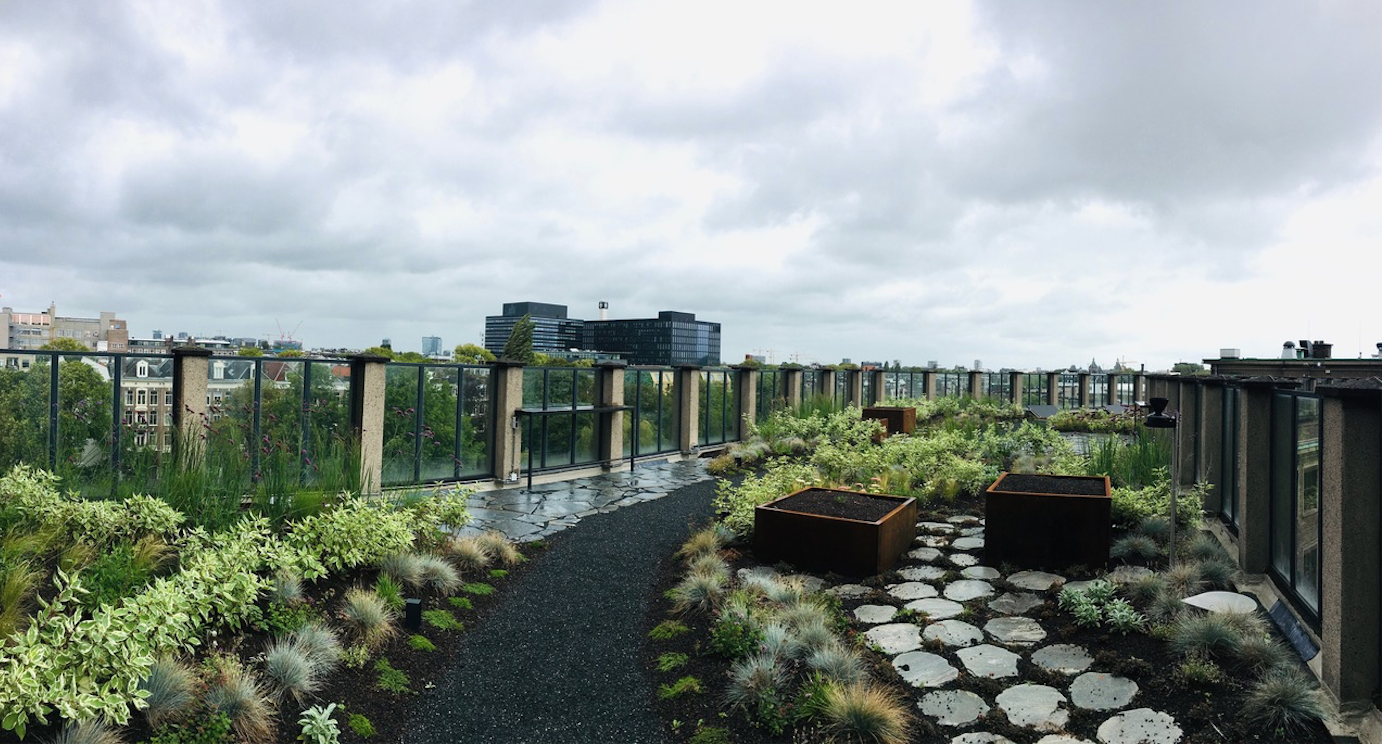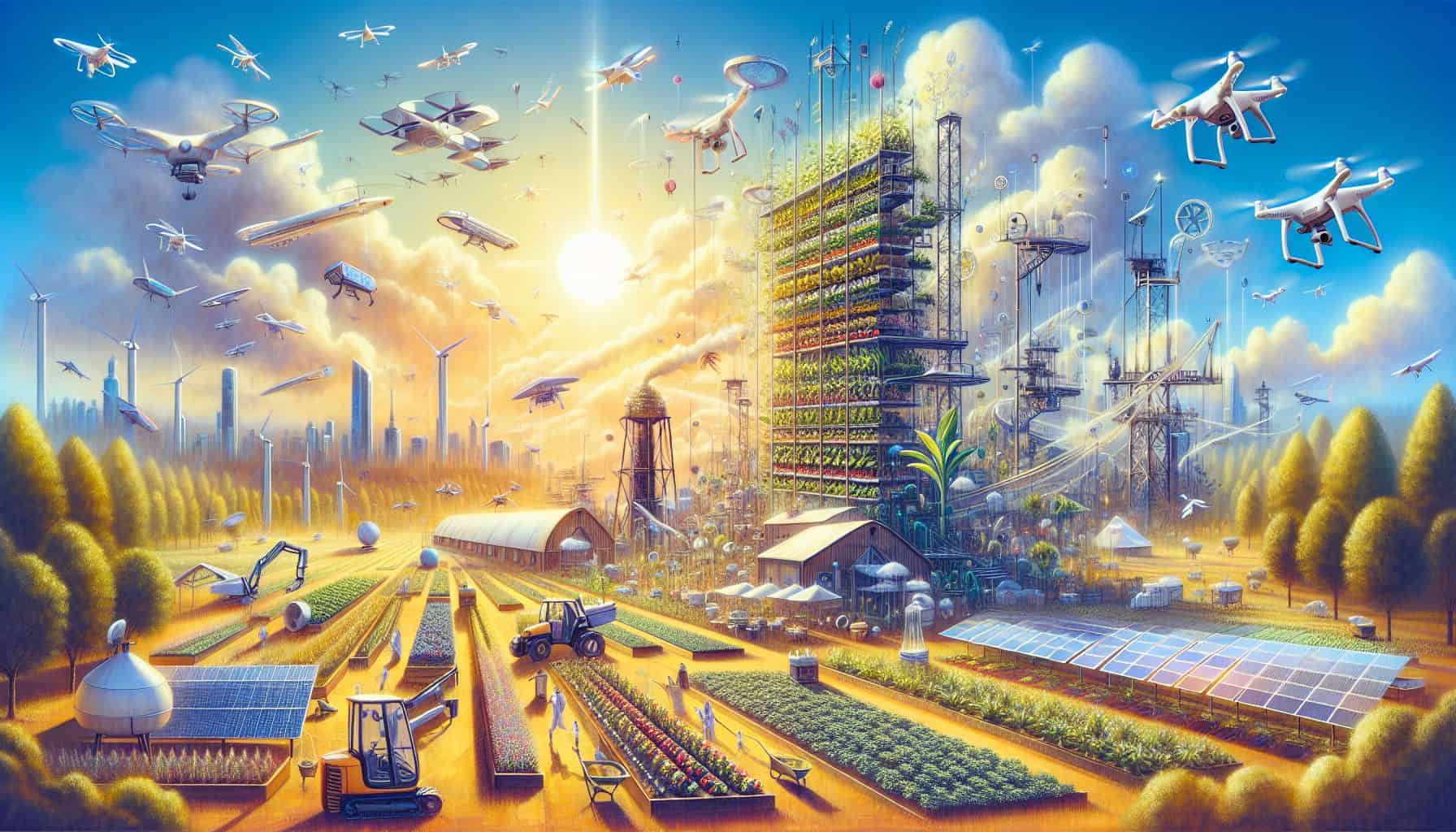
The Benno Premselahuis building of the Dutch Amsterdam University of Applied Sciences (HVA) in the eastern part of the Amsterdam center has an innovation lab on its roof since this summer. Located on top of the eighth floor, its purpose is to make the city climate-proof. It resembles a lovely small rooftop park where HVA students can look out over the city.
The small green-blue oasis is equipped with technological gadgets such as a rain gauge. As well as a smart dam that holds rainwater collected inside the garden. It then discharges that water when a rainstorm is on the way according to the latest online weather forecasts.
Four types of roofing materials
There are also four types of surfaces. One that uses water storage in combination with grass and flowers. Another uses water storage in combination with white gravel. Then there’s one covered with sedum (succulents/plants that spread over the surface) as found on conventional green roofs. Lastly, a water reservoir that does not have any vegetation.
A solar panel is mounted on each of the different roof surfaces. In addition, a solar radiation meter registers how much solar radiation hits the roof and how much is reflected back. There is also equipment that measures the roof surface temperature and heat flux. This should make it clear which roof structure insulates the building most effectively from excessive heat. It also needs to become clear how each type of roofing influences the solar panels’ efficiency.
“Based on the initial data, some variances can already be seen,” says Joost Jacobi. On behalf of Metropolder Company, Jacobi is responsible for the construction of this experimental garden on the rooftop of this building. Which was built in 1947 and originally served as housing for the former Dutch Labor Council (Raad van de Arbeid). “We’ll study the data this fall.”

Blue-green roof plan for Amsterdam
The rooftop on the Amsterdam University of Applied Sciences is one of the first smart blue-green roofs featured in a plan to make 10,000 square meters of rooftops blue-green. The goal is to provide the city, which is getting hotter and hotter each summer, with better protection from overheating. Water that falls as a result of heavy downpours needs to be conserved more efficiently for drier times. It then ends up in a container layer underneath greenery and footpaths that are made of lava rock. That’s a type of stone that retains water and as such, also helps in the collection of water. Moreover, the idea is that insects and birds will come to these kinds of rooftops which have a variety of plants so that biodiversity will increase.
A vista of Amsterdam rooftop nature
The Amsterdam smart roof plan is called RESILIO. The city of Amsterdam has initiated it thanks to a European subsidy from the Urban Innovative Action program run by the European Commission. This is part of the European Regional Development Fund. The municipality works together with three metropolitan housing corporations (De Key, Stadgenoot, and De Alliantie) in the residential areas of Kattenburg, Oosterpark, Indische Buurt, Slotermeer, and the Rivierenbuurt. Staff from the Institute for Environmental Studies at the Amsterdam Vrije Universiteit and the HVA will research the impact of the innovative roofs on the quality of life and biodiversity in the city. The blue-green roofs and the innovation lab’s research results also serve as examples for other European cities.
But the question for Jacobi is, which of all these weather-related gadgets are the most innovative? He thinks that this may well be the smart dam. A central computer operates this. It receives data from the sensors on the blue-green roof and links this to the most up-to-date weather forecasts.
Dam opens when rain is on the way
As a result, the valves of the dam open up even before a downpour hits and discharge the stored water into the stormwater drain. This then ends up in the sewer that is not overburdened at that point. By the time the rain hits, the roof can take on the water and free up the sewer which needs to drain away a lot of rainwater all at once. This helps prevent drains from flooding the street in case the pump stations are unable to pump the water away quickly enough.
The great thing about this polder roof is that it not only protects against problems caused by heat and water but that you can also walk around it to relax and unwind. Once they have grown, there will be trees in tall, square planters that you can sit underneath in the shade in summer. The flowers and the grass smell wonderful. “The blue-green polder roof on the VU even has water features,” says Jacobi. “Wee ponds, whose depth fluctuates depending on how much rainwater has fallen. You can also grow other types of plants there. That’s also very good for biodiversity as that attracts other insects too.”





